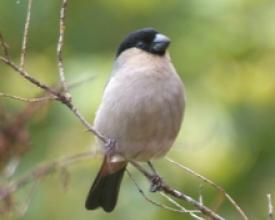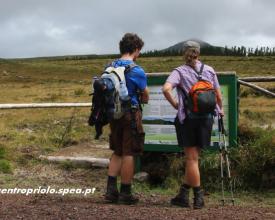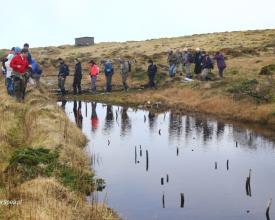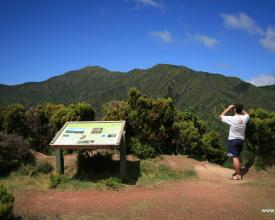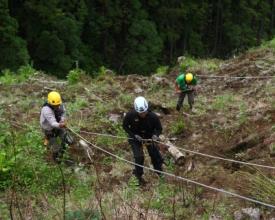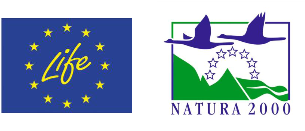
Lands of Priolo: Integrated management to save a bird, recover natural habitats and promote sustainability
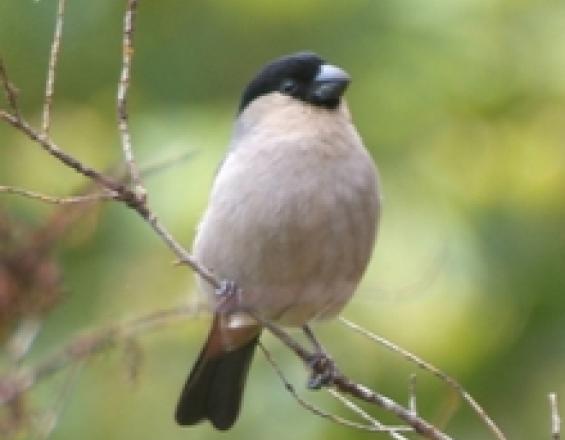
The Azores bullfinch Pyrrhula murina, Priolo in Portuguese, is one of the rarest and most endangered birds in Europe and can only be found in the east of the island of São Miguel, Azores.
For the last 15 years, habitat restoration and other conservation actions have been conducted on the Special Protected Area (SPA) where this bird is found. These projects have had excellent results for the conservation of this bird, improving its status from “critically endangered” to “vulnerable”, and recovering unique habitats: laurel forest and peat bogs.
Management strategy included maximizing positive local socio-economic impacts, like job creation, expenses, educational opportunities, infrastructure creation and ecosystem services provision. This positive local impact, as well as efforts to raise awareness, have turned this bird into a symbol. The “Lands of Priolo” are now working to develop sustainable tourism that contributes to conservation of natural resources and local development.
Context
Challenges addressed
The main environmental challenges are that invasive alien species (IAS), namely Hedychium gardneranum, Clethra arborea, Pittosporum undulatum and Gunnera tinctoria and invasive tree ferns, have dominated the original laurel forest reducing the food availability for the Azores bullfinch. Restoring these habitats is a costly and time consuming effort, intensified by the rough terrain, with very steep slopes that require adapting and developing techniques for IAS control, land stabilization and recovery of vegetation.
On the socioeconomic side, the project takes place in rural municipalities affected by depopulation and unemployment. It has been a challenge to turn a conservation project, not initially regarded as a priority, into an opportunity for development that is owned with pride by most locals.
Finally, ensuring long term economic sustainability is a challenge that we are still struggling with. We intend to address it by promoting economic opportunities linked to the Protected Area.
Location
Process
Summary of the process
Ecological restoration of natural habitats (1) is the main action of the project and was the first one to be started after the scientific diagnosis and the definition of a Species Action Plan. These actions are essential to ensure the long term conservation of the Azores bullfinch and natural habitats, and the continued provision of ecosystem services. Production of native and endemic species (2) is essential for the success of habitat restoration and it can also be used for environmental education and raising awareness.
However, ensuring support for these costly actions was an important issue. The Environmental Education Programme (3) was developed allowing dissemination among students and their families.
Raising awareness and spreading information through a visitor’s centre (4) improved the local perception of the project and, by attracting tourists, promoted local economic opportunities. Later, this increase in tourism was managed with all stakeholders through the Participatory Sustainable Tourism Planning (5).
Throughout the entire project, monitoring of Azores bullfinch population and restoration success (6) allowed problem detection and identification of management opportunities, and also provided valuable data for the project.
Building Blocks
Ecological restoration of natural habitats
Ecological restoration of Azorean laurel forest was the main conservation action developed for the recovery of the Azores bullfinch. Restoration is conducted by chemically removing the invasive species, since no manual or mechanical methods proved effective. After removal, soil stabilization is conducted, reverting to natural engineering techniques when necessary and the area is planted with native and endemic species produced in the nurseries. In patches of pure IAS stands, logging of invasive trees with chemical treatment and chemical treatments on standing trees have been tested and are used depending on the terrain conditions. So far, over 350 hectares of native forests have been restored, including 295 hectares of Humid Laurel Forests and 31 hectares of highly degraded Mesic Laurel Forests. This amount is expected to increase by 80 more hectares by the end of the present project.
Ecological restoration of peatlands was conducted by removing grazing cattle from the area, removing IAS (namely Gunnera tinctoria) manually, closing drainage ditches and inoculating peatland mosses into the flooding pools generated. This active restoration was conducted in an area of 75 hectares. This restoration experience has allowed us to develop techniques that have been replicated in Azores.
Enabling factors
- European Commission funding through LIFE Programme;
- Public ownership of the intervention area;
- Scientific and technical support from an advisory board;
- Development of specific techniques for IAS control and bioengineering techniques;
- Availability of an important number of native plants to be planted in the restored areas.
Lesson learned
- Ideally, IAS control interventions should be performed as soon as the first individuals are detected, otherwise those interventions will have much higher costs and be less effective.
- Using and adapting already developed techniques for ecological restoration can save a lot of time and improve success.
- We have been able to learn from our mistakes; continuous monitoring allows learning from practice and improving the techniques for IAS control, soil and slope stabilization with natural engineering and plant production.
- Monitoring and regular maintenance of restored areas are indispensable in ensuring long term success.
- Public awareness is a key factor in order to control the spread of IAS.
- Multisectorial and multistakeholder strategies for the management of IAS problems are necessary. They should be promoted at the highest level, but implemented at a local scale in order to include the specificities of each area.
- This restoration experience has allowed us to develop techniques that have been replicated in other areas of the archipelago by other entities.
Environmental Education Programme
A comprehensive environmental education program was developed for all levels of basic education, from pre-school to 12th year and including professional training. It includes activities adapted to the learning curriculum of each year. This way, school children would get information about nature conservation and its benefits while learning relevant concepts for their education. These activities are also offered to non-formal educational groups during the school holidays. More than 20,000 students have participated in a programme that has reached all the schools on the island.
The environmental education programme was designed with the contribution of teachers through several workshops that led to the definition of an education strategy. It includes a set of activities to be developed in the schools, ranging from lectures and practical classroom activities to more recreational activities and educational games. It also comprises some school visits to the Priolo’s Interpretation Centre, the Nurseries of Azorean Plants and the protected area.
Teaching tools and child-friendly materials were prepared for the programme and for teachers’ independent use. A certified teacher education program has been developed with 150 teachers trained so far.
Enabling factors
- European Commission funding through LIFE Programme;
- Interest from schools in participating in the programme;
- Restored areas available for visits by school children;
- The existence of a visitor's centre was useful although it was not essential.
Lesson learned
- After 10 years of implementing this environmental educational programme, we could verify the importance of this type of approach not only for the children and teachers involved but also as a dissemination tool for the community.
- Providing an opportunity for outdoor educational activities and providing activities that contributed to teaching curriculum subjects was a good way of improving adherence of teachers to the programme.
- Teachers’ training and teacher’s involvement in preparing the school programme was also useful to increase school adherence to the programme.
- Including more educational and more leisure activities is a good way to ensure the adherence of different types of education groups.
- In order to increase participation of teacher and students and promote multidiciplinarity of environmental issues it was important to propose activities for subjects like Portuguese, English, Social Sciences, etc. But, of course, science and citizenship were the subjects in which most of the activities were conducted.
Resources
Awareness raising and information for local and foreign visitors
The project’s communication strategy was aimed at the local population through press and social media. It was important to produce press releases and invite journalists to report on the project, as was communication through the internet and social media.
A regular programme of activities aimed at the general public, including volunteering activities, was developed. These activities allowed locals (and sometimes visitors) to participate in and learn about conservation activities taking place in the protected area, as well as learning about Azorean biodiversity.
In the end of 2007 the Priolo's Interpretation Centre was opened. Its mission is to raise awareness for the “Priolo” and its habitat, the Laurel Forest. It contains an exhibition that tells the story of Azores bullfinch, explains the conservation actions developed on the ground and talks about the biodiversity of the protected area and of the Azores archipelago. The Priolo’s Interpretation Centre increased the communication capability of the project. This centre provides information for visitors to the protected area and promotes educational activities for schools and the local population. This centre also has a small souvenir shop and donation box, gathering some funding for the implementation of the project.
Enabling factors
- Available funding through European Union Rural Development Funds (LEADER);
- European Commission funding through LIFE Programme;
- Partnership between regional government and an NGO in order to build the centre.
Lesson learned
- Creation of promotion materials and awareness campaigns are of great significance for the dissemination of the project and to increase the knowledge of the general population about biodiversity and its main threats, allowing the continued involvement of the population, which is crucial to ensure the preservation of natural resources in the long term;
- Improving public opinion about the project has also proved useful in gathering volunteers and donations that are of great help to the project;
- No matter how good media communication is, the best awareness raising and communication strategy is engaging the local population and word of mouth. The visitors' centre is of great help to achieve this engagement;
- We don´t charge entry fees, but ask for donations from our visitors, this promotes the entry of local population that sometimes repeat visits, and we still get some funding from foreign visitors. However, economic sustainability of the visitors’ centre is still a matter we are struggling with.
Participatory Sustainable Tourism Planning
In 2010, the Regional Directorate for the Environment, the Regional Directorate of Tourism, the Regional Directorate of Forestry Resources, the Portuguese Society for the Study of Birds, the Azores Geopark, the municipalities of Nordeste and Povoação, other institutions, private touristic companies and local people started a participatory process in order to develop a Strategy and Action Plan to promote the Lands of Priolo as a Sustainable Tourism destination.
This process led to the definition of a first action plan for five years (2012-2016) with 55 concrete actions. By 2016 66% of the plan was fully implemented and up to 88% was at least started. In 2016 this action plan was evaluated and a new action plan was developed with 77 actions and new partner institutions. The private tourism companies could also actively participate in the sustainable tourism plan through their own commitments by signing into the Priolo Brand.
This sustainable tourism planning was awarded the European Charter for Sustainable Tourism in Protected Areas.
Enabling factors
- European Commission funding through LIFE Programme;
- Willingness to participate in the touristic management process by all stakeholders involved;
- Diagnosis of tourism resources and sustainability issues.
Lesson learned
- This participatory tourism planning has been a continued learning process for all entities involved and it is still a work in progress in terms of creating an actual sustainable destination, however some important improvements have already been made;
- Improving inter-institutional collaboration is vital in order to improve efficiency in developing a sustainable tourism destination, this might be the greatest achievement of this process;
- Sharing knowledge between regional government departments, NGOs and tourism companies can enrich the decision-making process and help with finding more innovative and practical solutions for some governance and management problems;
- Continuous monitoring of implementation and sustainability indicators is very helpful in order to ensure results;
- Maintaining interest and involvement of all stakeholders is very demanding and requires constant attention and feedback. Also, it requires a good understanding of the motivation of each stakeholder, and some care in trying to deliver expected results as well as manage expectations in order to avoid disappointment.
Monitoring of Azores bullfinch population and restoration success
Every four years the "Atlas of Priolo" is conducted, with 50 volunteers counting all the priolos in the world in one or two days. This Atlas allows a more robust estimation of the priolo population size.
Annually a census of priolo is conducted by a project technician in May and June, and in September a juvenile census is conducted in order to assess the reproductive success of the species. Every four years a winter census is also conducted. This monitoring allows assessment of the population trends of the bird and quick action if any problem is identified.
Native vegetation evolution is assessed in all the intervention areas annually, comparing the composition of random 10 x10 metre squares of vegetation between restored areas and control areas. New plantations are also monitored to assess their success and identify problems. When an intervention area presents other sensitive issues, such as proximity of water lines, new monitoring schemes, for example water analysis, are put in place in order to ensure success and safety of all the interventions.
Finally, socioeconomic impacts of the project in terms of investment and ecosystem services provision are also monitored.
Enabling factors
- European Commission funding through LIFE Programme;
- Scientific support by an advisory board.
Lesson learned
- Good planning and regular implementation of monitoring actions is essential in order to obtain good and robust results;
- Scientific support of monitoring actions is very important, however, and since actual conservation actions are a priority, this monitoring needs to be adapted to reduced availability of economic resources and time to conduct these actions. Sometimes, it is necessary to find simpler ways of obtaining the answers we need in order to continue working despite not being totally scientifically rigorous. This is the case of ecosystem services provision assessment, which is conducted in qualitative terms, with some quantitative and monetary valuation, when the required information is available.
- Monitoring actions allow identification of best practices, redefining new interventions and improving efficiency, but they are also a good communication tool, allowing us to show the importance and success of the project and to present this to the general public. The Atlas do Priolo has become a great communication and engagement event.
Production of native and endemic plants
In order to ensure an adequate supply of native and endemic plant species for the restoration actions, it was necessary to increase the capacity of production in nurseries of endemic and native plant species. The Regional Directorate for Forestry Resources, an important partner in this project, already produced endemic and native tree species before the project started. Native and endemic species production has significantly increased since then.
However, the need for more species and, specifically, the need for herbaceous and shrubby species to ensure a higher percentage cover of the area, led the Portuguese Society for the Study of Birds to build a new nursery. This nursery is mostly focused on the production of herbaceous and shrubby species and is also important for planting areas with native and endemic species for seed collection, to be used for hydro-seeding techniques. Presently, these nurseries have an annual production of around 40,000 plants and around 160 kg of seeds.
These nurseries are also used for environmental education activities and for the promotion of the use of native species in gardening by the general public.
Enabling factors
- European Commission funding through LIFE Project;
- Knowledge sharing between entities.
Lesson learned
- Production of native plants was already in development in the Azores region, but the increase in production and the need of different species helped to improve the techniques used, as well as develop new techniques in order to improve the cost per plant.
- A good planning of all phases in plant production with a view to actual restoration needs can be of great use in terms of increasing efficiency and reducing both costs and loss of plants. It is very important to coordinate all phases of production, since each one can only take place at a certain time of the year and some species may take more than two years to be ready to put in the ground.
Impacts
This project has made it possible to recover more than 450 hectares of laurel forest and 83 hectares of peat bogs in the Azores, and to change the conservation status of the Azores bullfinch from “critically endangered” to “vulnerable” on the IUCN Red List. For this purpose, more than 200,000 endemic and native plants have been grown in nurseries and replanted.
The project also contributed to the local economy by creating an average of 21 full-time jobs, and ensuring the investment of about 85% of its budget in local businesses, developing and improving tourism infrastructure such as the visitors' centre and trails, and increasing international promotion of the Lands of Priolo and the Azores archipelago. Ecosystem services derived from ecological restoration have also been improved, such as improving water quality and supply and a reduction in erosion processes.
The project has organized environmental education actions in all schools of the island with 20,645 students reached so far; as well as general public activities with 9,451 participants and 27 training sessions for teachers and tourism guides with 1,149 participants to date.
The tourism planning process of the Lands of Priolo was awarded the European Charter for Sustainable Tourism, having implemented 36 actions and managing to involve 47 tourism companies as partners for conservation through the Priolo brand.
Beneficiaries
Local community has benefited from project investment, job and infrastructure creation. Tourism companies benefit from a more attractive destiny and training. Local schools have benefited from an outdoors science education programme.
Sustainable Development Goals
Story
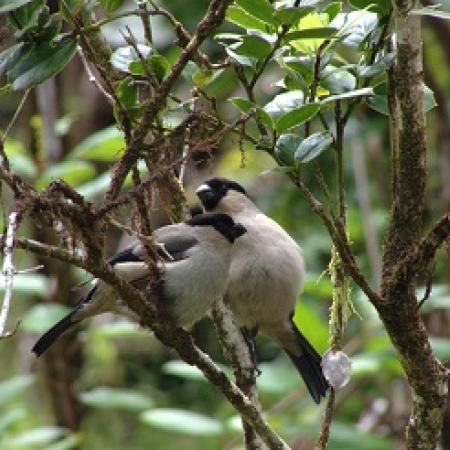
The Priolo: An Azorean conservation success
The priolo (Pyrrhula murina) is a small, black and grey bird with a chubby build. Globally, it can only be found in the municipalities of Nordeste and Povoação on the island of São Miguel, Azores - the Lands of Priolo. However, nothing would make the priolo different from the other species found in the Azores, if not for its history. An epic story of a bird that was persecuted as a plague almost to extinction, and later protected and cherished, managing to escape extinction.
In the past, the priolo was abundant to the point of being considered a plague and hunted by farmers. Priolos that found their food sources very reduced in the mountains due to deforestation would go in big flocks to feed in the orange groves. Later, in the mid-20th century, the priolo almost disappeared. It was so rare that the Carlos Machado Museum offered a reward to anyone who could give information about the species and it was sought after by many researchers globlly. At this time its population was estimated at less than 300 birds.
But it was not hunting or deforestation that proved to be thepriolo's worst enemy. Exotic plants brought into the island, mainly for gardens, grew at a quick pace and dominated the already degraded Azorean laurel forest – reducing its food source.
In the 1990’s, priolo conservation became of international concern and studies were conducted classifying it as “critically endangered”. At that time, the Portuguese Society for the Study of Birds and the Regional Government of Azores started to remove the invasive species and plant native species that could serve as food for the priolo.
Currently, the Azores have 450 hectares of recovered laurel forest with more than 200,000 new Azorean plants, some of which were as endangered as the priolo itself. Priolo populations have increased to around 1,000 and stay stable; the species is now considered "vulnerable".
The priolo has become a symbol: it has served as a flagship species for the recovery of peat bogs, which are essential for water supply; it has been the inspiration behind an environmental education programme for almost a generation of students; and it has allowed the promotion of a sustainable tourism destination with a successful biodiversity conservation story to tell. Furthermore, it has become a source of pride for the local population.

